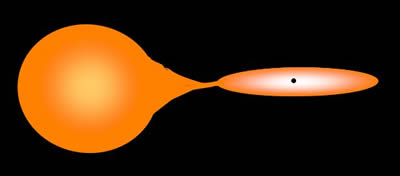U Geminorum Stars
U Geminorum stars are a type of variable star displaying sudden and unpredictable increases in brightness. Their brightness may increase by as much as 2 to 5 magnitudes over a period of hours, followed by a slower fading over days to weeks. This large variation means that U Geminorum stars are sometimes referred to as dwarf novae.
U Geminorum stars are a binary system consisting of a white dwarf and a red giant that has filled its Roche-lobe. The ensuing Roche-lobe overflow causes matter to fall onto an accretion disk around the white dwarf creating a ‘hot spot’ at the point of impact. Meanwhile, the matter already contained within the accretion disk spirals inward to ultimately fall onto the surface of the white dwarf.

This situation means that the light from a U Geminorum star has at least four sources: the two stars, the accretion disk and the hot spot on the accretion disk. The fluctuations in brightness are believed to result from an increase in the amount of material falling onto the white dwarf. Although the causes of these sudden increases in accretion rate are not fully understood, current ideas revolve around two basic mechanisms:
- a sudden increase in the transfer of material from the companion star to the accretion disk causes the disk to collapse onto the white dwarf.
- the accretion disk can only accumulate a certain amount of gas at a steady rate before becoming unstable. These instabilities can cause an increase in the amount of matter falling onto the white dwarf.
Currently, most astronomers believe that the second scenario is more likely to be correct.
See also: dwarf novae.
Study Astronomy Online at Swinburne University
All material is © Swinburne University of Technology except where indicated.

